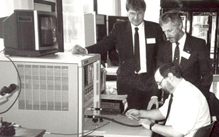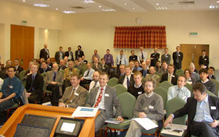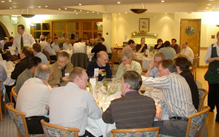The society was formed in 1982. Although it now covers all aspects of RF and microwave engineering the society was originally focused on automated measurement and was named the "Automated RF & Microwave Measurement Society" (ARMMS). It was originally modelled on the ARFTG society (www.arftg.org), which had been founded ten years previously in the USA. The society's original aims were to develop the use of computer automation in the RF and microwave industry. A significant part of this was of course to gently persuade the major instrument manufacturers to automate their equipment wherever possible.
Early papers were from Academia and Industry and focused on the automation and calibration of the then essentially manual vector network analysers. The time was ripe of course as the new "instrument controllers" were becoming available together with the standardized "General Purpose Interface Bus", IEEE Standard 488, introduced in 1975. Almost coincident with the birth of the ARMMS society was the introduction of the so-called "IBM" PC.
The improvements in productivity were immediately seen, but probably more important was the ability to calibrate at a large number of frequency points and make almost real time highly accurate measurements by comparing the results of a device against the data from known artifacts stored in computer memory. In addition to this "accuracy enhancement" as it was called, everyone was to see the benefits of mathematical manipulation and transformation of the test data. An early example of this was Marion Hine's and Harold E Stinehelfer's time domain software running on a local desk top computer instead of being sent to a mainframe for later analysis. Indeed Harold Stinehelfer was a presenter and after dinner speaker at one of the early meetings.
 |
 |
 |
The society was originally started with considerable help from Leeds University and RSRE at Malvern, and the very first meeting was held in the Spring of 1983 at Boddington Hall, Leeds. Early committee members included Harry Duckworth and Eric Griffin from Malvern, Roger Pollard from Leeds and Duncan McIntosh from Hewlett Packard. During the early 1990's, Ralph Yell from the National Physical Laboratory (NPL) took the helm as chairman, followed in 1998 by George Hjipieris of Nera.
Meetings were held twice yearly most years, and were often in University accommodation during vacation time to keep costs low. As the conference grew in size the society started using the facilities of modern hotels and conference centres.
Suppliers of electronic test equipment and software have always been encouraged to support the society and over the years a mini exhibition of the latest test equipment and software began to run concurrently with the conference. This is now a regular part of our meetings and in addition equipment manufacturers often sponsor individual meetings to help fund the running of the society.
The original aims of the society have expanded over the years as instrumentation has become more automated and we now cover diverse topics in Radio and Radar design and test, metrology, medical, materials testing etc.
Those people attending our meetings are deemed to be members of the Society. Besides the cost of attending each meeting there are no separate membership fees.
For an overview of the papers presented at past meetings, please click here.
for a paper specification for speakers, please click here.
For information on our next meeting please click here.
If you would like to know more about the ARMMS RF & Microwave Society, please contact:
Email: enquiries@armms.org